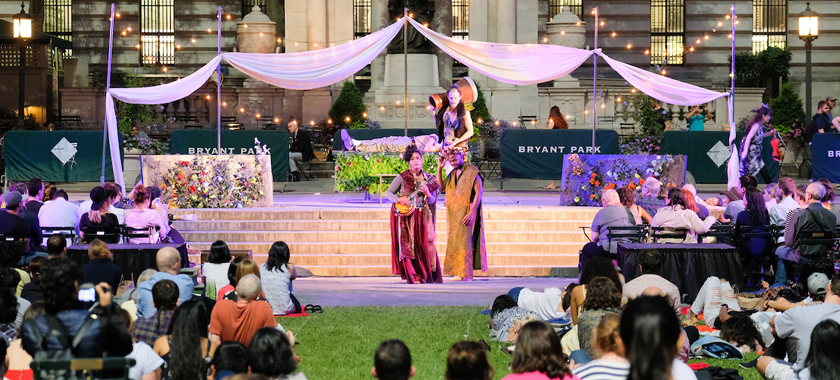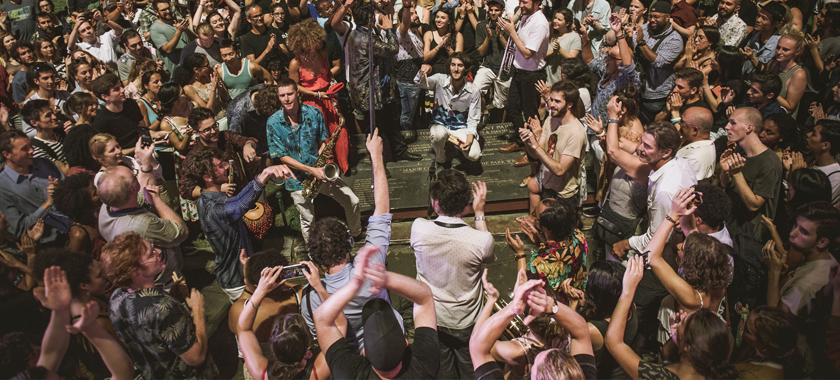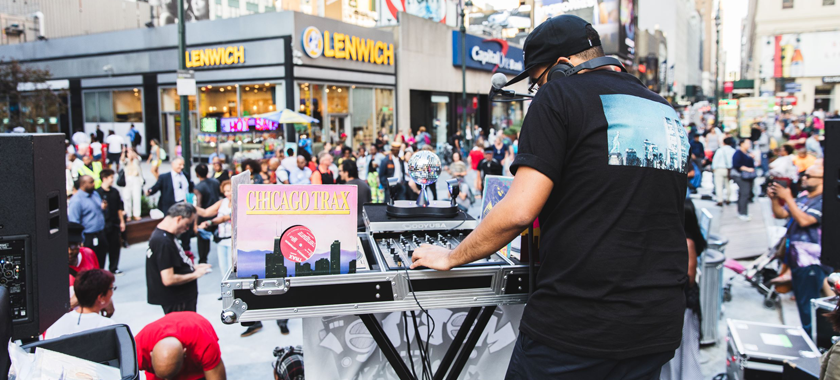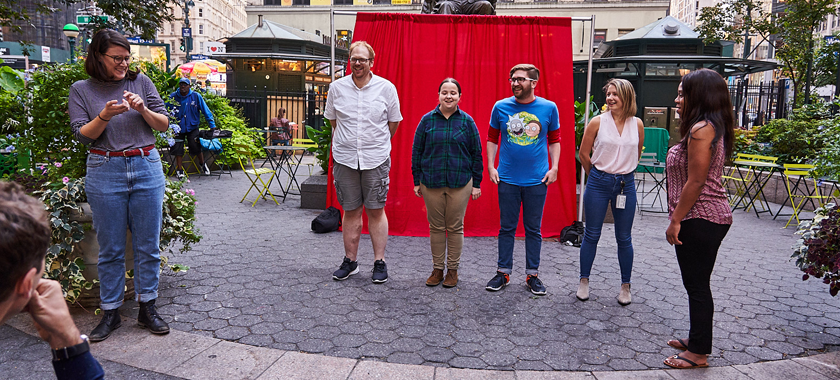
Business of Art | Performing Outdoors
Planning an outdoor event and not sure where to start? We’ve got insights from Dan Fishman (Emerging Leaders ‘16), Director of Public Events at Bryant Park and 34th Street Partnership.
Dan Fishman (Emerging Leaders ‘16) has an incredible range of experience working with outdoor events: small, large, and in-between. As Director of Public Events at Bryant Park and 34th Street Partnership, he’s seen it all, noting that “Bryant Park is one of the most densely programmed public spaces in New York City and the United States, if not the world.” Fishman recently joined NYFA Learning (virtually!) to give a presentation to New York City-based performing artists and event producers looking to create and perform outdoors. See below for our “101” on the topic. Even if you’re not based in New York, this post will help you start a checklist to work through as you plan your outdoor event.
Outdoors: Challenges and Opportunities
According to Fishman, indoor performance venues offer a lot of control over a project, which underscores why the vast majority of arts events happen in this context. Outdoor events offer a different way of experiencing a cultural activity. “You have much more flexibility, a lot less control, so you have to create these experiences in a different way,” said Fishman. “Being a part of that communal experience, where everybody around you is singing along if it’s a musical, or dancing or saying the lines with you, really is something special. Beyond that, you can meet people where they already are and where they want to be,” he added.
Unsurprisingly, some of the challenges to hosting your event in an outdoor setting are weather-related. Consider what rain, sun, wind, lightning, and extreme temperatures might mean for your presentation and have plans in place—including the possibility of rain dates or cancelling—in case weather threatens your event. Noise is also a challenge. In addition to thinking about how it might impact your presentation, you should also consider how your event will impact the surrounding environment. “Thinking about how you’re sharing the space with others is important and then with that comes a fair amount of restrictions and permissions from the city, which are also a challenge,” said Fishman.
Thinking about how you’re sharing the space with others is important and then with that comes a fair amount of restrictions and permissions from the city, which are also a challenge.
-Dan Fishman

DIY Outdoor Production
When planning an outdoor event, Fishman starts with the artists. He encourages you to first think about their (or your!) needs, what you want to accomplish, and what kind of location you need to meet your performance goal. Also consider what size you need for the performance area, including both the artist and audience needs for the space. “Back-of-house often gets forgotten, but it’s really important to have spaces for the equipment you need and for the artists and staff,” said Fishman.
The next big step, according to Fishman, are the practical, technical aspects of your production. Here, as always, budget plays a role. For example, are you working with a limited production budget (or none), or do you have a larger budget where you can do something more substantial? Fishman recommends creating a performance space so that when people walk by, they know that something is happening. Examples include raised areas, cones, barricades, tents, or even tape that visually communicate that “somebody put some thought into this.”
Fishman urges you to consider your sound, lighting, and electrical needs in a similar manner. For sound, “You can start from zero and use nothing so you can have unamplified performances. You can also do silent performances. For a group, like a brass band, you may not need to amplify in order to reach audiences. You can use megaphones, you can use simple amps like you might see a busker use, or a keyboard or simple speaker that has a few inputs,” said Fishman. With a less limited budget, you can use a basic speaker system, one sound engineer, and a mixing console. Those with larger budgets can consider a hung line array system, sound team, or dedicated equipment. For lighting, you can use the sun or work lights, on/off lights, or simple LED lights. Bigger budget projects move into hung lighting systems and lighting designer territory. This “sizing up” approach also applies to electrical needs.

Permission: Working with City Agencies
Pro tip: Do your research to know what options are available and when you’d need to apply for permits so that you can build it into your event timeline.
For example, you must apply for a Special Events Permit through New York City’s Department of Parks and Recreation at least 21 days ahead—and others may require 60 or even 90 days advance notice to be considered. A Special Events Permit is needed for all gatherings of 20 people or above, and there is a $25 fee to apply. You must also provide event date, time, and location as well as information on your expected audience; your marketing plan; and the sound, equipment, and vehicles you’ll employ. Said Fishman: “The vast majority of events that they permit are free and open to the public, so you won’t be able to get ticketed revenue from this.” If you visit the NYC Parks website, you’ll see a section titled “Parks Permits” prominently displayed on the site.
Permits for film shoots, street festivals, block parties, and commercial or promotional events that take place on the City’s streets, sidewalks, and pedestrian plazas over nine hours or less go through the Street Activity Permit Office (SAPO). You’ll need to apply for a permit at least 60 days prior to the event, and there is a $25 application fee. “One of the important things to know about SAPO permits is that they require commercial insurance. So if you’re an independent artist or producer, you may not have that and may want to consider partnering with other organizations that can help you with that,” said Fishman. Some SAPO permits also stipulate that the event be free and open to the public, without corporate sponsors, alcohol, or any corporate branding.
SAPO created a new program called Open Culture during the COVID-19 pandemic with the intent to make the permitting process easier for cultural organizations. There is a $20 fee instead of a $25 fee, and they’ve shortened the window so that you only have to apply for a permit 15 days in advance as opposed to 60 or more. This program also allows for paid tickets, so you are able to get an Open Culture permit and require people to pay money in order to see the event.
“One of the challenges with the Open Culture program is that you have to be an accredited arts organization with New York City, so you have to be part of the Cultural Institutions Group or get New York City Department of Cultural Affairs or other borough arts funding to get a permit. You need someone on board with the event who has that accreditation,” said Fishman. Additional challenges? You will still need insurance for this type of permitting, and you’ll have to present your event in a New York City Department of Transportation-sponsored Open Culture location. The good news is that there are locations throughout all five boroughs.
Depending on your event, you may also need to apply for permits with the New York City Department of Buildings (for structures above 10 feet tall), New York City Police Department (for amplified sound, no parking signs), the New York City Fire Department (for generators), and New York City Department of Cultural Affairs (for food and drink vendors). The list goes on, but these are just a few of the things to think about when planning your event. An alternative is to work with a privately-managed space or non-city space where you don’t need a location permit in the same way. You would, however, still need Department of Buildings, sound permits, and other City permits,” noted Fishman. An example is One Penn Plaza, which is a Privately Owned Public Space (POPS).

Resources and Community Partners
You don’t have to work alone. Fishman recommends that if you know you want to do an outdoor event and you have a location where you want to do it, that you reach out to the area’s Business Improvement District (BID). These groups may have existing permits that you can use, and they may have financial resources or other infrastructure (like sound equipment or electrical equipment) that they can help you with. Fishman also suggests looking into “Friends of” groups for parks who are knowledgeable about permit needs; they can also vouch for your organization with the New York City Department of Parks and Recreation and give advice about how to apply for permits. Collaborating with cultural organizations is another way to approach making your event a reality.
–Compiled by Amy Aronoff, Senior Communications Officer
You can find more articles on arts career topics by visiting the Business of Art section of NYFA’s website. Sign up for NYFA News and receive artist resources and upcoming events straight to your inbox.
NYFA Learning provides artists, creators, students, and arts administrators with tools, strategies, and advice for building sustainable careers. We collaborate with organizations, academic institutions, and cultural partners to bring our programs to a broad range of national and international creative communities.